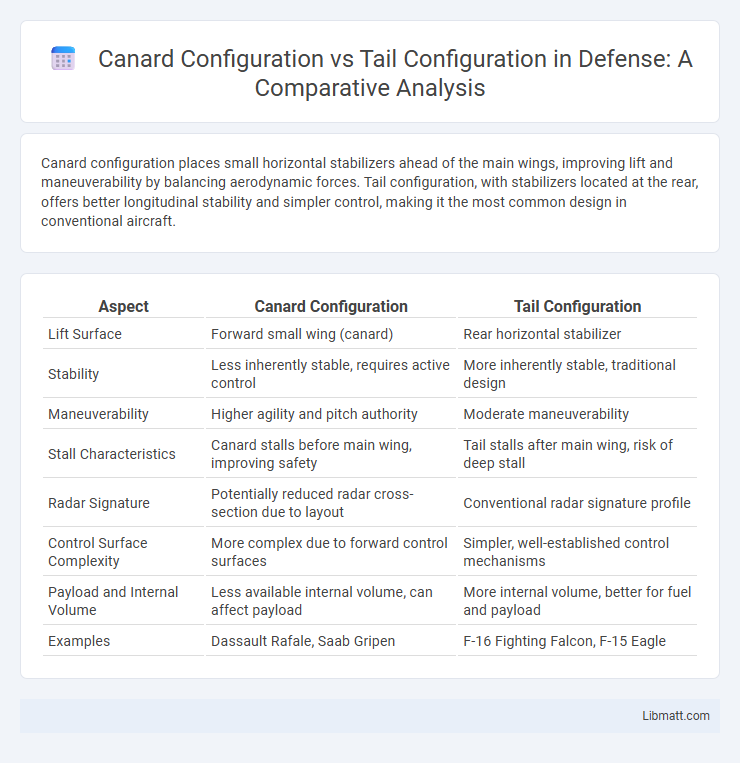Canard configuration places small horizontal stabilizers ahead of the main wings, improving lift and maneuverability by balancing aerodynamic forces. Tail configuration, with stabilizers located at the rear, offers better longitudinal stability and simpler control, making it the most common design in conventional aircraft.
Table of Comparison
| Aspect | Canard Configuration | Tail Configuration |
|---|---|---|
| Lift Surface | Forward small wing (canard) | Rear horizontal stabilizer |
| Stability | Less inherently stable, requires active control | More inherently stable, traditional design |
| Maneuverability | Higher agility and pitch authority | Moderate maneuverability |
| Stall Characteristics | Canard stalls before main wing, improving safety | Tail stalls after main wing, risk of deep stall |
| Radar Signature | Potentially reduced radar cross-section due to layout | Conventional radar signature profile |
| Control Surface Complexity | More complex due to forward control surfaces | Simpler, well-established control mechanisms |
| Payload and Internal Volume | Less available internal volume, can affect payload | More internal volume, better for fuel and payload |
| Examples | Dassault Rafale, Saab Gripen | F-16 Fighting Falcon, F-15 Eagle |
Introduction to Aircraft Configurations
Canard configuration places a small forewing ahead of the main wing, improving lift distribution and stall behavior compared to traditional tail configurations. Tail configurations include horizontal stabilizers at the rear, providing pitch stability and control with well-understood aerodynamic characteristics. Your choice between canard and tail configurations affects aircraft stability, control responsiveness, and aerodynamic efficiency.
Overview of Canard Configuration
Canard configuration features small forward wings located ahead of the main wing, enhancing lift and improving aircraft stability. Unlike the conventional tail configuration with a rear horizontal stabilizer, canards provide better control at high angles of attack and contribute to reduced drag. Your aircraft design may benefit from this layout by optimizing maneuverability and fuel efficiency.
Overview of Tail Configuration
Tail configuration, the most common aircraft design, features horizontal stabilizers at the rear of the fuselage, providing stability and control during flight. This setup allows for efficient pitch control and contributes to the overall aerodynamic balance by counteracting nose-down moments. Your aircraft's tail configuration is crucial for maintaining steady flight and ensuring responsiveness to pilot inputs.
Aerodynamic Principles: Canard vs Tail
Canard configuration offers enhanced lift distribution by placing the horizontal control surface forward of the main wing, generating positive lift that improves overall efficiency and reduces stall risk. Tail configuration relies on a rear horizontal stabilizer providing downward force that balances the aircraft but can increase drag and decrease lift efficiency. The canard's forward lift shifts the center of pressure forward, promoting better pitch control and potentially higher maneuverability compared to the conventional tail setup.
Stability and Control Comparison
Canard configurations offer enhanced pitch control by locating the foreplane ahead of the main wing, improving maneuverability and reducing stall risk, while tail configurations provide inherently greater longitudinal stability through a rear horizontal stabilizer. The canard's positive lift contribution can lead to a more efficient lift distribution but requires precise design to avoid pitch sensitivity and control coupling. Your choice depends on the specific balance between control responsiveness and passive stability required for the aircraft's mission profile.
Advantages of Canard Configuration
Canard configuration offers improved aerodynamic efficiency by providing better lift distribution and enhanced stall characteristics, reducing the likelihood of a deep stall. This layout typically results in increased maneuverability and stability at low speeds, making it ideal for fighter jets and experimental aircraft. Additionally, the forward control surfaces in canard designs can contribute to reduced drag and improved fuel efficiency compared to traditional tail configurations.
Advantages of Tail Configuration
Tail configuration offers superior longitudinal stability and control due to the larger moment arm provided by the horizontal stabilizer at the rear of the aircraft. It enhances pitch authority, allowing for more precise and predictable handling characteristics across a wide range of flight conditions. The conventional tail arrangement also facilitates simpler structural design and maintenance compared to the canard layout.
Common Applications and Examples
Canard configurations are commonly used in advanced fighter jets like the Eurofighter Typhoon and Saab Gripen, where enhanced maneuverability and reduced drag are critical. Tail configurations dominate commercial airliners such as the Boeing 737 and Airbus A320, offering stability and ease of control in large, passenger-carrying aircraft. Unmanned aerial vehicles (UAVs) and experimental planes often explore canard designs for improved aerodynamic efficiency and control responsiveness.
Efficiency and Performance Analysis
Canard configurations enhance aircraft efficiency by reducing wing loading and improving lift distribution, leading to better maneuverability and stall characteristics compared to traditional tail configurations. Tail configurations offer proven stability and ease of control due to their conventional empennage design, often resulting in higher drag but more predictable handling for diverse flight conditions. Your choice between canard and tail configurations should consider specific performance goals, balancing aerodynamic efficiency with control stability requirements.
Choosing the Right Configuration: Key Considerations
Selecting the right aircraft configuration involves evaluating aerodynamic efficiency, stability, and control characteristics. Canard configurations offer improved lift distribution and stall resistance by placing control surfaces ahead of the main wing, enhancing maneuverability and reducing drag. Tail configurations provide superior pitch stability and simpler structural design, making them optimal for traditional aircraft requiring consistent control response and ease of maintenance.
canard configuration vs tail configuration Infographic

 libmatt.com
libmatt.com